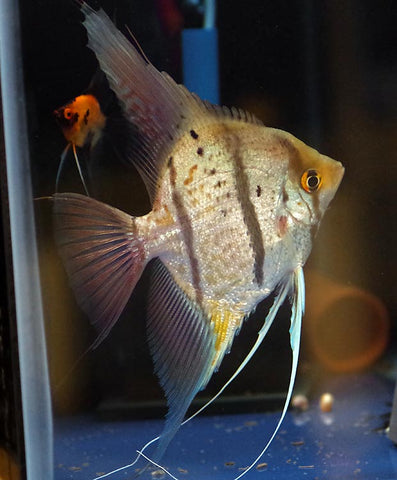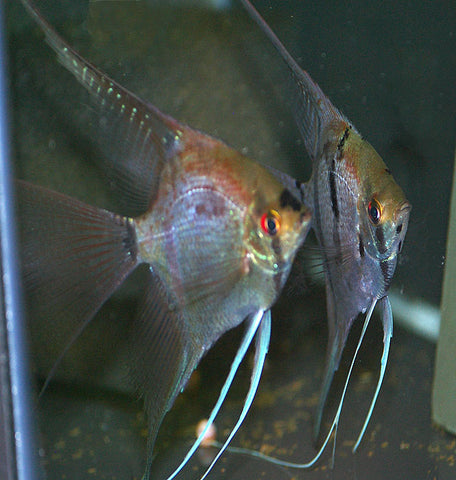We occasionally get requests from people who would like to see an update on a project. Wild-cross projects tend to be some that are most often asked about. I should do these updates more often. It's not the writing that gets me. It's photography. I used to think that I would love it. Just give me a high-quality camera, which I have, and I will really enjoy taking all sorts of photos. I guess that's not the case. Apparently I just don't have the patience for it. It probably sounds strange coming from someone who has been raising angelfish for 40 years, but if the pictures don't look as good as the subject I will work at it for a while then I hear that little voice in my head saying "Well, enough of that". I just got done wasting an hour on some angels that didn't want to cooperate, so... I'm going to do the update and go with what I got. Fortunately, I got a few decent shots the other day so they aren't all bad : )
You may remember that we took a large wild Peruvian Scalare male and bred it to a high-quality veil Koi female.

All wild crosses are interesting and unique. Body shape, color, and temperament make each cross well worth the effort, however, the F1 generation creates a somewhat bland looking silver gold marble ghost. The Gold Marble gene from the Koi is co-dominant with a bit of marbling showing through, but not much color. The stripeless gene that creates the blushing trait tends to break up the bars on the wild silver. Fortunately, the Peruvian genes add a lot of subtle color and speckling to help keep them interesting.
From here we went in two directions. The first pairing was made with two F1 fish from the original cross. The siblings used to create the pair are pictured below.

This pair produced 27 different types of fry ranging from 50% wild type to 50% wild Koi superveil. I decided to keep only the Koi and Blue Koi. Both varieties grew out as expected, with the Koi showing orange crowns and the Blue Koi a dull gray.

Next we did a back-cross using the same 50% wild from the above F1 pair and a nice orange Koi from the HR line. We selected two pairs. Both looked very similar.
Pair 1 Orange male Koi veil x f-1 50% wild Koi cross female
Pair 2 Orange female Koi veil x f-1 50% wild Koi cross male

These pairs both produced 12 different types of fry. Again I kept only the Koi and Blue Koi. These results were however nothing like what we expected! The pairs just above produced the biggest advances in color by far. The results of similar wild crosses, made years ago, never came close to these in terms of orange coverage. I would generally expect to back-cross at least one or two more generations to get these results. The photo below compares a solid 25%-wild Koi on the left (F1 backcrossed to our best Koi), to a 50%-wild Koi on the right which came from one of the above F1 pairs. Both fish retain the very nice finnage and body shape but only the back-cross (25% wild) inherited the ability to produce complete orange coverage.
The Blue Koi (Gm/+ S/S)were a big surprise. A number of them don't really qualify as blue koi. They are very different. Rather than the typical iridescent bluish-gray color, they have a strong underlay of orange that shows through the gray creating a very unique fish. We will know more when we see the offspring that these fish create when crossed back to orange koi one more generation. We're looking forward to that.

